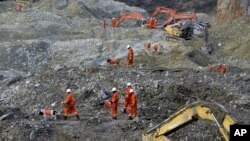Chinese rescuers have found 15 more bodies of miners buried by a huge landslide in Tibet, and frantically searched for survivors from Friday's disaster despite dwindling hopes of finding anyone alive.
The official Xinhua news agency said the bodies were uncovered Sunday, raising the confirmed death toll to 17, with another 66 miners still missing. The miners were at a camp in the Maizhokunggar county of the Tibetan Autonomous Region when the mountain above them collapsed early Friday, burying them under a vast pile of debris 20 to 50 meters deep.
Xinhua said a majority of the 83 workers at the camp were majority Han Chinese migrants from the provinces of Gansu and Guizhou. Several were Tibetans from the provincial capital, Lhasa.
The copper mine near Gyama village is operated by a subsidiary of China National Gold Group Corporation, a state-owned enterprise that is the country's top gold producer. Chinese President Xi Jinping and Premier Li Keqiang ordered authorities to exert maximum efforts to rescue the buried workers.
Xinhua said rescuers are working around the clock at the site, using excavating machines to clear debris and widening roads to allow more equipment to be brought in. But it said the high altitude and snowy weather at the site led to some rescuers suffering altitude sickness and fever.
The state news agency quoted a policeman as saying there is a potential for secondary landslides because of cracks in the mountaintop.
Xinhua quoted the head of China's work safety administration, Yang Dongliang, as saying an "in-depth investigation" will be carried out to find the cause of the disaster, and that the final results will be made public.
China has expanded the development of mining in Tibet in recent years, using its abundant minerals and metals to fuel the fast-growing Chinese economy. Beijing says the mines also help to raise living standards in underdeveloped Tibet. But Tibetans have long complained that mining damages the environment and takes away their natural resources while leaving them with little benefit.
Tibetans held a protest against Chinese mining in the Phenpo region earlier this year, gathering outside a mine and shouting slogans before authorities dispersed them. The protesters complained that Chinese authorities expropriated their farmland to enable mining work to expand, resulting in their livestock dying from a lack of pasture.
Tibet's India-based government-in-exile said the landslide could be a result of aggressive Chinese mining in the Gyama valley. It called on Beijing to make "sincere efforts" to determine the "real cause" of the disaster, follow up with "appropriate measures" and ensure "active" participation of Tibetans in the region's decision-making process.
VOA's Tibetan service contributed to this report.









